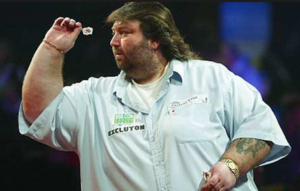The above video demonstrates a technique of dart throwing which I have pioneered, called Dart Dunking.
Dart Dunking – A method of dart “throwing” in which the participant jumps from behind the dart throwing line and places or slams the dart onto the board before his or her feet hit the ground.
Much like in basketball, in darts the highest percentage shot is going to be the one taken closest to the target. Throwing a dart from behind the legally recognized line, which is placed 7 feet 9.25 inches in front of the dart board, is going to be much less successful than jumping from behind the line and placing the dart onto the board, much like a jump shot in basketball is less probable to go in the hoop than LeBron James slamming the ball through it.
In order to accomplish dart dunking, thereby guaranteeing yourself, barring any slips and falls, seizures, or foul play, a perfect score in any game of darts you may choose to play in, including the prestigious World Professional Darts Tournament held annually in London which I will be participating in and winning, one must simply be a well above average, though not necessarily great broad jumper.
A broad jump is basically an augmented long jump in which an athlete plants his feet and jumps as far as he can. Factoring in arm length as well ample time for mid-air calculation, this means, you need to be able to consistently broad jump around 8.5 feet. Keep in mind that you will need to be able to accomplish this repeatedly, upwards of hundreds of times per tournament. As a reference point, Dallas Cowboys safety Byron Jones broad jumped 12 feet 3 inches at the 2015 NFL combine, which would make him an unstoppable dart player.
If, like myself, you are a one foot jumper, you will have to do some basic training until a broad jump feels natural for you. There are no rules barring getting a running start, yet most professional dart tournaments take place indoors, often on stages or other confined areas, and there may not be ample room for you to get an Olympic long jump style approach.
I know what you’re thinking at this point. Clearly this is against the rules. You’re wrong. The Professional Darts Corporation is the leading darts organization in the world, and is overseen by the Darts Regulation Authority, which is the “Governing body of professional darts.”
Their rules do not mention anything about jumping over the line when throwing a dart. Below is the entire set of rules regarding throwing:
5.2.1 A Player shall throw darts from a standing position, excepting only in those circumstances when a physical disability or physical injury requires a Player to
adopt a non-standing position (for instance from a wheelchair or similar form of
support).
5.2.2 All darts must be deliberately thrown in an over arm fashion, one at a time, by and from the Player’s hand.
5.2.3 A “Throw” shall consist of a maximum of three darts thrown consecutively (without interruption for any throw by any other Player) by a Player unless a leg, set or
match is completed in less than three darts thrown by that Player.
5.2.4 If the throwing Player physically touches any dart which is in the dartboard during a Throw, then that Throw shall be deemed to have been completed.
5.2.5 Any dart bouncing off or falling out of the dartboard prior to being retrieved by the throwing Player after that Player’s Throw does not count and shall not be rethrown.
The only language which could potentially outlaw dart dunking would be the definition of a throw, and that it should be done in an “Over arm fashion.” In basketball, a dunk is still a shot. For this reason I’m inclined to believe that in darts, a dunk is still a throw. As long as you don’t dunk the dart in an underhanded fashion, you should be in full compliance. (Also, what does it matter if you want to throw a dart underhanded. In basketball you can shoot a ball underhanded. In baseball you can throw a ball underhanded. In football you can kick the ball to a receiver if you want to…)
The short answer as to why dart dunking has never been addressed by the Professional Darts Corporation is likely that they could have never conceived of it. Professional dart players are not an athletic bunch, and they often smoke and drink. For example Andy Fordham, who won the 2004 World Darts Championship while weighing in at over 400 pounds, claims to have drunk 25 bottles of beer before each tournament. It’s safe to say, given that this matter has to my knowledge never before been addressed, no current professional dart players are solid broad jumpers.
After I win my first championship, the DRA will probably be tempted to ban dart dunking, yet I would urge them against standing in the way of progress.
Dick Fosbury was the first high jumper to go head first over the bar, winning an Olympic gold in 1968, inventing the Fosbury Flop and revolutionizing the sport in the process. Today, all high jumpers do the Fosbury Flop. Outlawing a superior technique would have been a tragedy.
In the early days of professional basketball, players like Bob Kurkland and Wilt Chamberlain popularized the dunk. The NCAA briefly outlawed it during Kareem Abdul Jabar’s time playing at UCLA, and history doesn’t look back kindly on that decision. There was a first player to shoot a jump shot, a first player to shoot a slap shot, and a first player to bunt.
I will no doubt spawn many imitators and make many enemies as traditional stand-and-throw dart players fade into obsolescence. Yet, revolution is never easy. Watch for me at the World Darts Championship, I’ll be the one holding the trophy.

